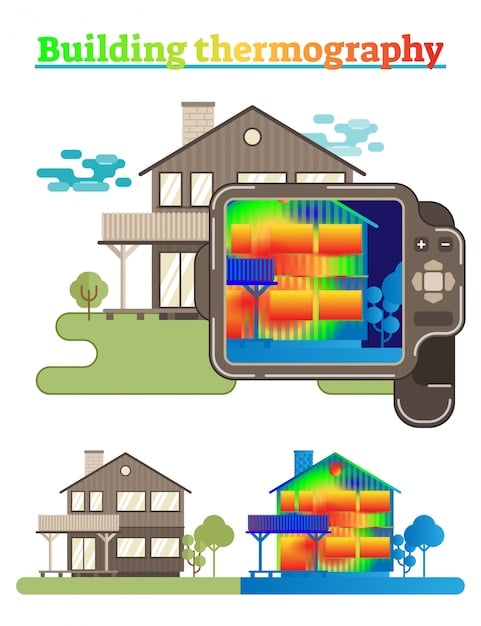Tornado Preparedness: A Comprehensive Family Safety Guide

Tornado preparedness involves understanding warning systems, creating a family safety plan, and taking proactive steps to protect your loved ones and property from the destructive power of these severe weather events.
Tornadoes can strike with little warning, making tornado preparedness crucial for the safety of your family. This guide helps you understand warning systems and create an effective family safety plan.
Understanding Tornado Warning Systems
Tornado warning systems are designed to provide timely alerts, giving you and your family crucial minutes to seek shelter. Knowing the types of alerts and how they are disseminated is a vital first step in tornado preparedness.
These systems utilize advanced weather technology to detect and predict potentially dangerous weather conditions. It is important to understand the difference between a watch and a warning.
Tornado Watch vs. Tornado Warning
Understanding the distinction between a tornado watch and a tornado warning is essential for effective tornado preparedness. Each signifies a different level of risk and requires a different set of actions.
- Tornado Watch: This means conditions are favorable for tornadoes to develop in the area. You should stay informed, monitor weather updates, and have a plan ready.
- Tornado Warning: This means a tornado has been sighted or indicated by weather radar. Immediate action is required to seek shelter and protect yourself.
- Stay Informed: During a watch, monitor local news, weather apps, and NOAA Weather Radio for updates. Be prepared to act quickly if a warning is issued.
Receiving timely alerts can significantly improve safety. Knowing where to get these warnings is part of tornado preparedness.

Sources of Tornado Alerts
Having multiple sources for receiving tornado alerts ensures you stay informed even if one system fails. Rely on these methods to stay updated during severe weather.
- NOAA Weather Radio: This network broadcasts weather warnings and information 24/7. A NOAA Weather Radio with Specific Area Message Encoding (SAME) can be programmed to alert you only for your specific county.
- Local News Channels: Television and radio stations provide up-to-date weather information, including warnings and safety tips.
- Weather Apps: Numerous smartphone apps offer real-time weather alerts based on your location. Ensure your app settings are configured to send notifications for tornado warnings.
- Outdoor Sirens: Many communities use sirens to alert residents to severe weather. However, these are designed to warn people outdoors, so don’t rely on them as your sole source of information.
In summary, understanding the warning systems and having access to timely alerts are critical for effective tornado preparedness. Stay informed, stay safe.
Developing a Family Communication Plan
A well-developed family communication plan is crucial for staying connected and informed during a tornado or any other emergency. Establishing clear communication channels and meeting points ensures everyone knows what to do if separated.
This plan should include multiple ways to stay in touch, as well as a designated meeting spot in case you are not together when a tornado strikes. Preparedness is key to mitigating chaos.
Designated Meeting Points
Choosing designated meeting points can help reunite family members after a disaster. Select locations that are easily accessible and known to everyone.
- Local Meeting Point: This could be a neighbor’s house, a community center, or a local park. Choose a place that is familiar and relatively close to home.
- Out-of-Town Contact: Designate a friend or relative who lives out of the area as a point of contact. In a widespread disaster, it may be easier to call someone out of state than to reach local numbers.
- Alternate Routes: Identify multiple routes to your meeting points in case roads are blocked. Keep maps in your emergency kit.
Clear communication strategies are a vital part of your communication plan. Tornado preparedness includes having these strategies in place.
Communication Strategies
During a tornado, communication lines can become overloaded or disrupted. Having multiple communication strategies ensures you can stay in touch with family members.
- Text Messaging: Text messages often go through when phone calls cannot. Establish a family text group for emergency updates.
- Social Media: Use social media platforms to check in and let others know you are safe. Consider creating a private family group on a social media site.
- Two-Way Radios: In case of power outages, two-way radios can provide a reliable means of communication. Ensure you have charged batteries.
A family communication plan provides peace of mind and ensures everyone knows how to stay connected during a tornado. Tornado preparedness requires proactive communication planning.
Creating a Home Emergency Kit
A well-stocked home emergency kit is an essential component of tornado preparedness. This kit should contain supplies to help you and your family survive for at least 72 hours in the event of a disaster.
Creating a kit involves gathering essential items that address basic needs such as food, water, first aid, and hygiene. Having these supplies readily available can significantly improve your safety and comfort during and after a tornado.
Essential Supplies for Your Kit
Your emergency kit should include a variety of supplies to meet different needs. Here are some essential items to consider:
- Water: Store at least one gallon of water per person per day. Plastic bottles or water pouches are convenient options.
- Food: Pack non-perishable foods such as canned goods, protein bars, dried fruits, and nuts. Choose items that require no cooking.
- First Aid Kit: Include bandages, antiseptic wipes, pain relievers, and any personal medications.
- Flashlight and Batteries: A reliable flashlight with extra batteries is essential for navigating in the dark.
Additional personal supplies can enhance the functionality of your emergency kit. Tornado preparedness means planning for all scenarios.
Personal and Comfort Items
In addition to the basics, consider including items that provide comfort and meet specific personal needs. These items can improve morale and make the situation more bearable.
- Medications: Pack a supply of any prescription medications, as well as over-the-counter remedies for common ailments.
- Personal Hygiene Items: Include items like soap, toothpaste, toothbrushes, and feminine hygiene products.
- Cash: During a power outage, ATMs may not work. Keep some cash on hand for essential purchases.
- Important Documents: Make copies of important documents such as identification, insurance policies, and medical records. Store them in a waterproof bag.
In conclusion, assembling a comprehensive home emergency kit is a critical part of tornado preparedness. Regularly check and update your kit to ensure you are always ready for any emergency.
Identifying Safe Shelter Locations
Knowing where to go during a tornado can save lives. Identifying safe shelter locations both at home and in public places is a key element of tornado preparedness.
The safest place to be during a tornado is an underground shelter, such as a basement or storm cellar. However, not everyone has access to these, so it’s important to identify alternative safe spots.
Safe Spots at Home
Within your home, certain areas offer more protection than others. Identifying these safe spots will help you make quick decisions when a tornado threatens.
- Basement: If you have a basement, go there immediately. Stay away from windows and exterior walls.
- Interior Room: If you don’t have a basement, choose an interior room on the lowest level, away from windows and exterior walls. A closet, bathroom, or hallway can provide good protection.
- Reinforced Safe Room: Consider constructing a reinforced safe room within your home for added protection.
For those in public places, knowing the designated tornado shelters is crucial. Tornado preparedness includes awareness of these public shelters.
Public Shelter Options
When you are away from home, knowing where to find public shelters can be life-saving. Look for these options in your community:
- Community Shelters: Some communities have designated storm shelters that are open to the public during severe weather events.
- Schools and Government Buildings: These buildings often have designated safe areas for students and employees.
- Hospitals: Many hospitals have reinforced areas that can provide shelter during a tornado.

Identifying safe shelter locations is a crucial aspect of tornado preparedness. Make sure everyone in your family knows where to go in case of a tornado.
Practicing Tornado Drills
Practicing tornado drills is an essential part of tornado preparedness. Regular drills ensure that everyone in your household knows what to do and can react quickly and effectively when a tornado threatens.
Conducting drills helps to identify any gaps in your preparedness plan and reinforces the importance of staying calm and organized during an emergency. It ensures people act quickly and safely, reducing the chances of injury or panic.
Frequency and Timing
Regular drills are key to ensuring your family is prepared. Here are some guidelines to help you schedule and conduct effective tornado drills:
- Frequency: Aim to conduct tornado drills at least twice a year, preferably in the spring and fall when tornado activity is most common.
- Timing: Vary the time of day to replicate different scenarios. Conduct drills during the day, in the evening, and even at night to ensure everyone knows what to do regardless of the time.
- Include Everyone: Make sure all family members, including children and elderly individuals, participate in the drills.
Making your drills realistic ensures people are actually prepared for a potential tornado. Tornado preparedness includes realistic simulations.
Realistic Drill Scenarios
To make your tornado drills as effective as possible, create realistic scenarios that mimic actual events. This will help your family members react appropriately and confidently during a real tornado.
- Simulate Alert: Use a weather app or NOAA Weather Radio to simulate a tornado warning. This will add a sense of urgency to the drill.
- Designated Roles: Assign specific roles to family members, such as gathering the emergency kit, assisting elderly individuals, and ensuring pets are safe.
- Evaluate and Adjust: After each drill, evaluate what went well and what could be improved. Use this feedback to adjust your plan and make future drills more effective.
Regular tornado drills reinforces safe procedures. Tornado preparedness requires active participation and practice.
Reviewing and Updating Your Plan Regularly
Tornado preparedness is not a one-time task. It requires regular review and updates to ensure your plan remains effective and relevant to your family’s needs.
As family circumstances change, so should your preparedness plan. Regular updates ensure your plan stays relevant and effective, providing the best possible protection during a tornado.
Assessing Current Needs
Regularly assessing your family’s current needs is a crucial part of maintaining an effective preparedness plan. This includes reevaluating your supplies, communication methods, and shelter locations.
- Inventory Supplies: Check the expiration dates on food and water in your emergency kit. Replace any expired items and replenish supplies that have been used.
- Update Contact Information: Ensure all contact information for family members and emergency contacts is up to date.
- Review Shelter Locations: Confirm that your designated shelter locations are still safe and accessible.
Keeping up with new best practices can enhance your preparedness plan. Tornado preparedness is an ongoing process of learning and adapting.
Incorporating New Information
Stay informed about the latest technologies, guidelines, and best practices related to tornado preparedness. Incorporating new information into your plan can improve its effectiveness.
- Stay Informed: Subscribe to weather alerts and monitor local news for updates on severe weather preparedness.
- Evaluate New Technologies: Explore new weather apps, communication devices, and shelter options that may enhance your preparedness plan.
- Seek Expert Advice: Consult with local emergency management agencies or weather experts for guidance on improving your plan.
Regularly reviewing and updating your preparedness plan ensures you are always ready for a tornado. Tornado preparedness is a continuous process of assessment, adaptation, and learning.
| Key Point | Brief Description |
|---|---|
| ⚠️ Warning Systems | Understand the difference between tornado watches and warnings and know where to get alerts. |
| 📱 Communication Plan | Establish meeting points and communication strategies for family members during a tornado. |
| 🎒 Emergency Kit | Prepare a kit with water, food, first aid, flashlights, and personal items for at least 72 hours. |
| 🏠 Safe Shelters | Identify safe locations at home and in public places, such as basements or interior rooms. |
Frequently Asked Questions (FAQ)
▼
A tornado watch means conditions are favorable for tornadoes to develop in the area. A tornado warning means a tornado has been sighted or indicated by weather radar, requiring immediate action.
▼
It’s recommended to conduct tornado drills at least twice a year, preferably in the spring and fall, when tornado activity is most common. Vary the time of day to simulate different scenarios.
▼
The safest place is an underground shelter, such as a basement or storm cellar. If you don’t have one, an interior room on the lowest level, away from windows and exterior walls, is the next best option.
▼
Your kit should include water (one gallon per person per day), non-perishable food, a first aid kit, a flashlight with extra batteries, medications, personal hygiene items, cash, and copies of important documents.
▼
Stay informed by monitoring NOAA Weather Radio, local news channels, weather apps on your smartphone, and outdoor sirens. Having multiple sources ensures you receive timely alerts.
Conclusion
Being prepared for a tornado involves understanding warning systems, developing a comprehensive family communication plan, creating a well-stocked emergency kit, identifying safe shelter locations, and practicing regular drills. By taking these proactive steps, you can significantly enhance the safety of your family during a tornado.





